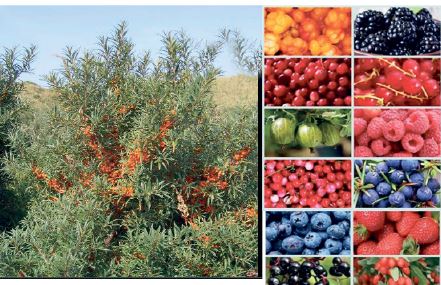SEA BUCKTHORN BUSH (Hippophae rhamnoides)… found throughout Europe and Asia at the snow line areas, the berries are rich in vitamins A,C, K, N & E, minerals and anti-oxidants (inset) famous berries of the world…strawberries, blueberries, raspberries, gooseberries, cranberries and many more.
By Tara Narayan
THE world of berries is enchanting. I must confess that I is only recently my imagination woke up fully to the wild world of berries and other people in other countries dress up appropriately to go picnicking wild berries in season, in distant countries like Finland, Sweden and other north European countries come their brief summers. Must be a terrific experience which I may envy!
A rosary of berry names come to mind from the aristocratic blue berries, cranberries, loganberries, goji berries to India where we love strawberries (never mind how infested with pesticides they are), raspberries I don’t see too often, nor mulberries. Although in Goa we have our wild berries like karvanda/kantam (in Konkani), which I say are the cranberries of India! And “chunnam,” (pearly white astringent sweetness), “chirputam” are very interesting because they come in their own tissue wrappers and cousins of a Peruvian Inca berries); I am not sure if the famous fat-busting kokum are berries or fruit (although a berry is a fruit too of course). Then we have a variety of “boram” small and big, “jagoma,” is the royal purple jamun a rare tree berry and what about the much loved hog plums or “ambade” – two sizes, small ovals which are very sour and large balls with sweeter tartness ….no, I don’t they qualify to be berries.
Since the wild berries of the Konkan coast are varnishing in the wild it is high time some wilderness farms cultivate them through permaculture or whatever as berry lands! The Konkan tropical berries are as delicious and packed with much desired life-preserving nutrients as the temperate wild berries I have in mind — since last week here I wrote briefly about seabuckthorn berries from the mountains of the Himalaya in Ladakh, Lahaul & Spiti, Kinnaur.
TREKKING many years ago down the Kargil mountains and valleys, by a silky charcoal river with velvety turf-side meadows studded by starry white edelweiss, I now recall picking up a bag full of the wondrously delicious Ladakhi amber apricots. Vaguely, I recall the berry bushes which we were not in too much of a hurry to get entangled with…I don’t remember seeing any seabuckthorn trees though, my loss, must go again once more time to look for them!
Most berries come on bushes and not trees and many can be terribly thorny affairs. From the picturesque looks of it the glossy orange seabuckthorn berries (locally called chharma or churma maybe) rest safely in their nest of thorns. To get at the tempting booty you better produce a sharp scissors or bush knife. I haven’t tasted the fresh berries but some weeks ago at a Goa hospitality show I found seabuckthorn sauce (despite the addition of sugar as a preservative) deliciously tart and memorable on the palate – these berries are rich in malic acid, as in apples. Taste more like pineapple!
The berries are worth their weight in gold fruit! This seabuckthorn or Hippophae rhamnoides is a species of some eight such spiny, deciduous shrubs, growing from the Atlantic coast of Europe across northwest Mongolia and China and Northern Pakistan…in the cold, dry dessert of Ladakh, Lahaul & Spiti, Kinnaur. Seabuckthorn or chharma bushes are flowering, fruiting and spiny bushes.
Reportedly, mountain locals stay young forever eating these berries! And now the rest of the world in high utopian places is seeking seabuckthorn berries in their urban speciality stores where you may find a super foods section of organic produce (seeing how health-conscious we are becoming regardless of whether we may be able to afford or not afford the good life).
The lovely thick-skinned seabuckthorn berries are variously called sea berries, Siberian pineapple, sandthorn or sallow thorn, etc, and swear to have anti-aging properties. Research has proved this plus a couple of other medicinal properties like seabuckthorn berries may be naturally blood thinning, cause bleeding if you too many of them. They are berries for diabetics…basically, they’re healing berries to indulge in judiciously in fresh or dry form, in purre, jam, sauces, sherbet and I understand the oil is the magic oil locals grow up with to keep their skins protected against harsh sunshine.
Before I forget seabuckthorn berries are said to be 12 times more rich in vitamin C than oranges! The research has also yielded evidence that 3g of seabuckthorn oil taken for three weeks results in “better vaginal tissue integrity.” That’s the work of viamin C of course, it’s a pity most of us are not cognisant to the importance of fresh vitamin C and enzymes in our day-to-day life. I keep telling myself to drink a lemon worth juice in water daily in the morning but keep forgetting like I am already senile.
WELL, this is to say get some berries in your life if you want nitric oxide flowing through your cardiovascular system anew. Look up seabuckthorn produce by logging on to Urban Platter and other sites which stock and retail organic super foods – which can very definitely make up for nutritional deficiencies and losses in most urban and housebound residents young or old who are suffering increasingly in our times for no good reason.
I think in Himachal Pradesh they are now promoting seabuckthorn orchards but then these days anything good is likely to be for the export market — instead of made available at reasonable prices to the people of Bharatdesh! Indian healthcare comes last on the list of our powerbrokers anxious to mint their millions and trillions.
